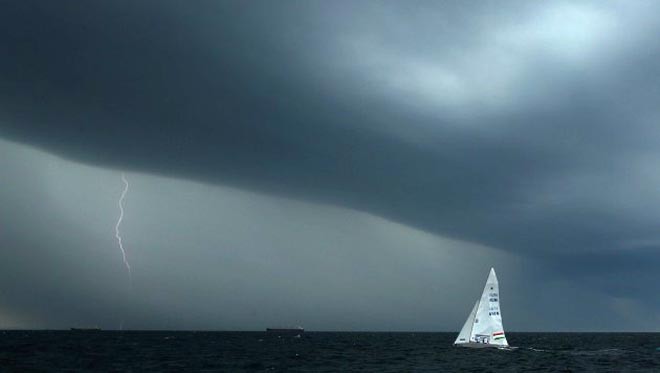Lightning kills one crewman on Philippines boat
by Nancy Knudsen on 3 May 2013

If possible veer away from thunderstorms when there is still plenty of time SW
Lightning has killed one crewman in a boat off the waters of Tabina in the Philippines. It was a fishing boat, not a sailing boat, but just as tragic and serves to remind all leisure sailors that lightning is dangerous on any boat if the crew is not prepared and knowledgeable.
Reynaldo Torres, Captain of the boat reported that he and nine crewmen on board their boat, Wingston, were sailing back to Tabina town when the lightning struck at around 5:42 p.m. on Wednesday.
One of the crew members identified only as Edgar, died on the spot. The crewman had defied, or was ignorant of well-known rules about thunderstorms, and was outside the deck when the lightning struck. The strike was so strong that it threw the victim off the boat into the water.
Torres said they immediately conducted search and rescue lasting for five hours to recover the victim, but failed to find him.
Police who investigated the reported death of the crewman found that the communication facility consisting of two-way radios, antenna and wire connections were all damaged as a result of the high voltage discharge by the lightning, and the hull of the boat was cracked.
From the sailor's point of view, there are many different techniques to protect personal safety when faced with a thunderstorm at sea.
Avoiding thunderstorms:
First, the thunderstorms themselves are best avoided. There are several techniques that can be employed to recognize a growing storm and track one that is moving in your direction. The thunderstorm, or cumulonimbus cloud, is best recognized in its forming stages by its tightly packed 'cotton wool' appearance. This occurs because a tremendous amount of energy is being released to produce powerful convection inside and around the cloud. Of course, if the thunderstorm is forming directly overhead the cotton wool appearance will not be visible, only a gray overcast that slowly darkens and eventually produces torrential rain, lightning and strong winds. The first few flashes of lightning in a
thunderstorm typically do not reach the ground and may be completely invisible during daytime.
One way to determine what is going on in the area is with a cheap AM radio. (Note: FM radios do not work nearly as well for lightning detection.) The characteristic crackle that we call 'static' on an AM radio is caused by lightning. A common problem in summer is that there are too many storms within radio range, which may be hundreds of miles. In order to
lower the sensitivity of your radio to distant storms, tune it to a local radio station, or, if the signal is too strong, slightly off tune. Any loud static can then be interpreted as a warning that things are charging up.
Once a thunderstorm starts to produce lightning that hits the ground or 'ground flashes', these can be used to locate a thunderstorm. One method is to track a collision course using a hand bearing compass, as you would a ship at sea: if the bearing to the lightning does not change, on average, the storm is heading your way and it is time to adjust your course. Another method that works once the thunder can be heard is to count the time between the light and the thunder. Since the light arrives almost instantaneously and the thunder travels at a speed of 1/5 mile/second, this time divided by five gives the distance to the lightning. For example, if the thunder starts 30 seconds after the lightning, the flash is 6 miles away.
Personal safety during a potential lightning strike:
One you cannot avoid the thunderstorm, the basic rule is to get away from the waterline, stay dry and inside the cabin if there is one, and stay as far away as possible from the mast and all large metal objects. Put a GPS unit inside a microwave or an oven, as reports are that the strength of a lightning strike will cause all metal objects on board to be 'zapped', even if you have the best kind of lightning protection on the boat.
If you want to link to this article then please use this URL: www.sail-world.com/109085